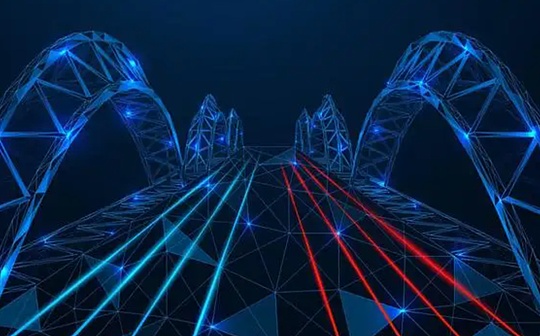
Author: Michallwy, BlockCrunch Author; Translation: Bit Chain Vision Xiaozou
There are currently three main cross -chain any message transmission (AMP) protocol:LayerzeroAs well asWormholeandAxlarEssenceI think Axlar is one of the largest players in the field of cross -chain protocols and will give 10 reasons in this article.My analysis will be carried out around three key areas: fundamentals (ie, technology), finance (ie, token economics and valuations), and emotions (that is, narrative and hype).
A cross -chain information transmission (AMP) protocol is a mutually operating solution that supports any data blocks (including tokens, chain status, contract calls, NFT or governance voting) from chain A to chain B.
AxlarAs well asLayerzeroandWormholeIt is the three most well -known cross -chain AMP protocols, all of which have the characteristics of external verification.This means that their cross -chain transactions are verified by third parties that do not belong to the blockchain involved.Although there are other verification types of cross -chain bridges, such as native verification methods (such as L2 Rollup and COSMOS IBC) and local verification methods (such as Connext), our focus is to understand these external verification AMP protocols.
Considering that they all use external verification, what is the difference between these three protocols in the specific practice?The answer is their trust mechanism.We can divide the external verification agreement into three categories according to different trust mechanisms: trust pledge holders (human), trust economics/gaming theory, trust mathematics/code.
>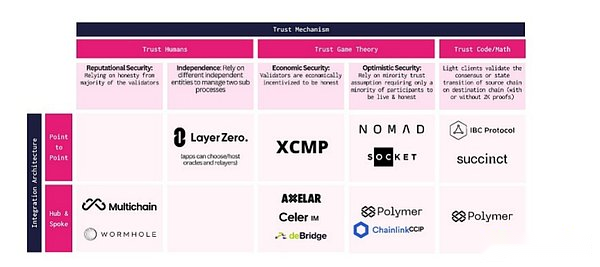
· Trust pledge holder (human): This method depends on the reputation of a specific entity to verify the transaction.
· Trust economics/ /Game theory: Vermitters take integrity in order not to face the risk of losing the mortgage.The concept is that the economic loss caused by improper behavior will exceed any illegal income.
· Trust mathematics/ /Code: Before transferring assets to other chains, use zero -knowledge technology and simplicity to verify the status of a chain.
Layerzero and Wormhole both belong to the category of “trust pledge holders”.Let us briefly understand their mechanism:
InLayerzeroUse two types of validator (verification/device): “Oracle” and “Relayer”.Oracle is essentially a contract address, which can be transferred to a block head.It transmits the block header information from the source network to the target network.Relayer (relay/device) submits message validity proof based on the block header provided by Oracle.Only when Oracle and Relayer confirmed the accuracy of a message, the message was considered valid.
InWormholeThe use of authoritative proof (POA) model depends on a set of external validator (19) called “Guardians” (Guardian).Guardians observe information and sign the corresponding effective load.Each Guardian executes this step separately, and then forms a multiple signature, that is, a certain state has been observed and confirmed.As Guardians, there are well -known companies such as FIGMENT, Everstake, ChainLayer, and Certus One.
In contrast, Axlar is different from the other two in the trust mechanism:
InAxlarThe COSMOS SDK runs the entrusted interest certificate (POS) mechanism and uses the encrypted economy to ensure security.It has a collection of 75 Validator in coordination by Tendermint.Validator is incentive to be incentive from block rewards, and it will face penalties for illegal operations or long -term downtime.The reliability of the agreement is supported by the governance mechanism established by Validator’s financial commitment and an agreement.Axlar Validator also uses the threshold signature scheme (TSS) to jointly maintain the account on each blockchain.
The simple summary is:
InLayerzero: Trust is placed on two entities running Relayer and Oracle.
InWormhole: Trust is placed on about 19 authorized Guardians.
InAxlar: Trust is above the economic guarantee of 75 validator pledge.
1, Fundamental
(1.AxlarAs a cross -chain agreement with the highest degree of trust to minimize, stand out
From the previous part, we can see how Axlar stood out because its trust requirements were the lowest.Let’s compare the architecture of Axlar, Layerzero and Wormhole more specifically.
>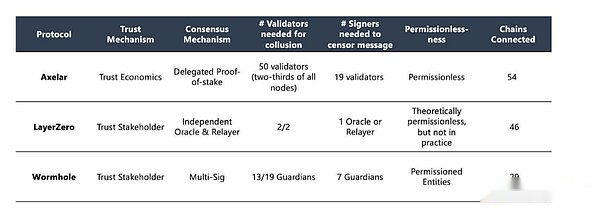
Layerzero’s architecture revolves around “Oracle” and “Relayer”.OracleGet the block header (section of the block) from the chain A and send it to the chain B for mutual state verification.In theory, there is no need to be licensed. Anyone can become Oracle. At present, the default is Google Oracle, and another option chainLink.RelayerProvide events on the chain A proves that as a basis for the behavior of chain B.The important thing is that Relayer is responsible for ensuring safety and execution.In theory, Relayer does not need to be permitted. Anyone can run Relayer, but it is actually operated by Layerzero.
This is why the structure of Layerzero was laughed at“2/2Sign“EssenceThe integrity of the bridge depends on the independence of Oracle and Relayer, and they can retain data to review messages.Although Layerzero allows customized Oracle and Relayer settings, in practice, setting personal Oracle and Relayer is very challenging and expensive, so few people do this.In this way, because the default configuration depends on the trust of several entities, it has brought restrictions on security, activity and resistance.
Wormhole uses an authoritative proof model, which is more decentralized than Layerzero, but still needs to be permitted.It depends on 19 “Guardians” from the authorized entity.When 13 of the 19 validator agreed, cross -chain messages are considered valid.This protocol includes a “Govenor“Function can suspend large transactions and add a layer of security. However, the participation of entities like the former Validator FTX shows the potential risks that only rely on reputation trust.
Axlar’s trust method is very unique, relying on the economic guarantee of 75 active Validator networks to provide a higher degree of decentralization.In the case of a few people in the POS system, a secondary vote adopted by Axlear (Quadrantic voting) It plays a vital role in maintaining decentralized decision -making.
Generally, blockchain governance operates in the principle of “one -generation currency corresponding to one vote”. Among them, the voting rights are linearly increased as the tokens increase.However, Axlar’s secondary voting mechanism increased the cost of each vote, effectively curbing the centralization of power, and encouraging a more balanced influence distribution.
This protocol requires the entire Validator set to reach at least60%Consensus can verify cross -chain messages.This threshold ensures that the effectiveness of the message does not depend on the size of a specific Validator subset serving a specific chain.
In addition, in order to enhance the security of the network, Axlar also formulated speed limit function.By setting the upper limit of the total amount of asset value that can be transferred within a given time, the network effectively minimizes any potential loss caused by unpredictable events.Axlar’s application -level security additional component also allows developers to customize the creation of security rules.For example, Defi applications can set specific restrictions on fund transfer, transaction frequency, and large transfer settings.
(2.Hub & amp; spoke(Wheel spoke) Extended model is better than point -to -point model
Axlar’s cross -chain architecture adopts hub & amp; spoke network topology.This is significantly different from the point -point design of Layerzero.
Let’s transmit cross -chain messages as a flight system for airlines: just like the long -distance flight through the central airport of the big city, Axlar passes messages and transactions through a central platform -the AXLAR POS Chain -the AXLAR POS Chain.This method reduces the connection that needs to be operated, simplifies monitoring, and is easier to upgrade.
Another thinking mode is to see Layer Zero as a two -way radio, which can be established directly between two users.In contrast, Axlar’s operation is more like a honeycomb network. The communication is sent to different endpoints through the honeycomb signal tower (representing the HUB center).This is reflected in its adaptability and configurable.
>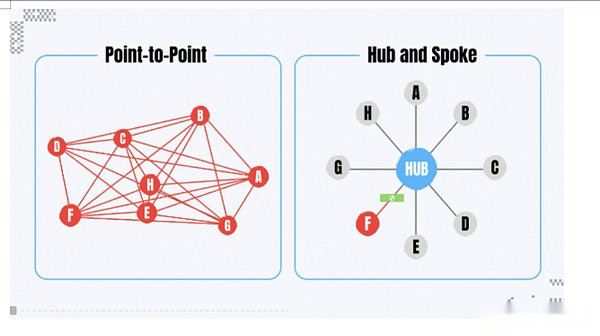
In the Hub & Amp; Spoke model, we can see that the network connection is more “tidy”.But in addition to the organization’s “cleanliness”, it is also related to cost benefits and effective management.In fact, we can see that in the real world, many systems use the wheel spoke model:
· Healthcare Network: Central Hospital (HUB) provides professional services such as trauma care, and local clinics (SPOKES) provide basic care and diagnosis.This setting ensures the centralization efficiency of professional services, and basic needs can be obtained locally.
· Library system: Main Library (HUB) has a wide range of collections and resources, while the local branch (SPOKES) meets the specific needs of the community and ensures that professional resources can be widely acquired.
· Foreign Policy: After World War II, the US foreign policy in East Asia adopted the alliance system of “Hub & AMP; Spoke”. In the bilateral alliance network, the United States is the center “HUB”, and other countries are “SPOKES”.Essence
Another advantage is that the central HUB can improve efficiency when crisis.In the point -to -point network, the isolated connection may not be detected at the same time.Axlar reduced this risk by centralized interaction, thereby enhancing network security and response capabilities.For example, when another bridge protocol Multichain interrupted due to the detention of its founder, the cross -chain exchange service built by Axlar can maintain safety and liquidity through isolation problems.
The most obvious criticism of the hub & amp; Spoke model is the risk of heartization: if the HUB fails, the entire network will be damaged.In Packy McCormick’s in -depth research on Layerzero, Layerzero founder Bryan pointed out:
(For the cross -chain agreement) Exist a middle chainIntersectionCosmosAs well asAxlarAs well asWormholeOtherIntersectionCome to listen to the incident and do it for effectiveness“yes/ /no“Judgment and send messages.Everyone trusts the role of the middleman. Once there is a problem with the people in the middle, it will affect all related blocks.
The key here is that in the cross -chain network, the central component is inevitable.Although Layerzero emphasizes direct two -way communication, it still depends on a certain form of “middleman” role.Axlar realized that forcibly letting the blockchain that was not interactive played this role is a fundamental defect of the point -to -point system.0xpostman has a good summary about this:
The core point here is that in the point -to -point system, connectedL1The blockchain is actuallyhubsEssenceMost blockchains are not designed as a interoperable center, and it is a mistake to use them in this way.
Another advantage of the hub & amp; the spoke model is its scalability.In the network composed of “n” nodes, only “N-1” routing can connect all nodes in the hub & amp; spoke system.For example, a system with 10 nodes requires only 9 routing to connect all points.Instead, the point -to -point system with the same number of nodes will require 45 routing to fully connect.When we expect that the surge in L1, Rollup and the application chain in the future (a state of “a” blooming flower in the hundred chains “), the limitations of this point -to -point model become more obvious.
(3.AxlarVirtual machine (AVM) It will promote cross -chainDappdevelop
Axlar virtual machine (AVM) is developed based on COSMWASM and converts interoperability into a programmable layer.It enables developers to write smart contracts directly on Axlar, expand their cross -chain projects, and at the same time abstract cross -chain tasks (such as token exchanges) to reduce the burden on developers.AVM has the following characteristics and functions:
· No license to connect to the new chain: AVM supports connections without licenses with the new chain, and supports the technical expenses required to integrate the new blockchain.This function is called Interchain AMPLIFier. It simplifies the process of supporting the new chain by encouraging Validators to gather AXL token through a third -party source.
InInterchain Maestro: This tool enables developers to deploy and manage multi -chain DAPP instances.Interchain Maestro’s concept of “one construction, running everywhere” simplifies the development process.A recent update shows that cross -chain tokens (ITS) will launch a test network in July.ITS expands tokens across the chain while maintaining its native attributes, providing the team with a simple way to manage and manage supply and functions.
So what does this term mean?What can be created true?Ben Weinberg from Axlar provided some ideas on a community forum:
· Cross -chain liquidity: cross -chain distribution liquidity to enhance the liquidity of smaller networks.
· Cross -chain income optimization: Maximize income opportunities across multiple chains.
· Cross -chain pledge: pledge across multiple blockchains.
· General Wallet: Create a wallet with a unified generation currency balance and actually cross -chain operation.
· Cross -chain market: Construct a NFT market that integrates multiple blockchain.
AXLAR, which has AVM, can well support the transition to cross -chain applications. Among them, the application aims to seamlessly run across multiple chains and break the barriers of the isolated network.In fact, we have seen some examples in this area:
InSommelierIt is a multi -chain income vault developed based on the COSMOS SDK, and has a high -value EVM network.Its vault will be dynamically adjusted according to market conditions or indicators set, which will generate strategies that are more adaptable and profitable.Sommelier uses the Axlar bridge to connect other EVMs to allow interactions with smart contracts in its native environment to execute a re -balance.
InOJOIt is a cross -chain Oracle network built based on COSMOS SDK. It uses Tendermint BFT to reach a consensus, which is specifically spread and disseminated for data from decentralized cross -block sources.Validators on OJO can actively provide approved data sources and receive rewards for their contribution.OJO uses Axlar’s cross -chain smart contract and IBC protocol to effectively convey pricing information.Validators provide real -time data of asset prices, which are summarized and verified on the chain.
(4.Layerzero v2ShowAxlarReal“layer 0“
The name Layerzero can be said to be a handwriting from marketing genius.It expresses the concept of Layer 0 (L0) of the blockchain -conveys the meaning of interoperable layer running under L1 blockchain.However, the name itself does not define the function.Although the name is Layerzero, its function is more in the application level of the interoperability field, and Axlar, although not seen from the name, is closer to the true essence of the Layer 0 protocol.This has become more obvious in the recently released Layerzero V2.
>
Let’s take a look at the specific comparative analysis of Layerzero and TCP/IP protocols:
“ifTCP/IPIt is the opening agreement of the Internet, I thinkLayerzeroCan become a full -chain (Omnichain) The opening agreement, the full chain is a blockchain network, all of which have their own differentiation points.“
If we observe it carefully, we will find that different functions are still available in the TCP/IP model.TCP/IP is a layered server architecture system, and each part is defined according to a specific function.All four layers work together to transmit data from one layer to another.
>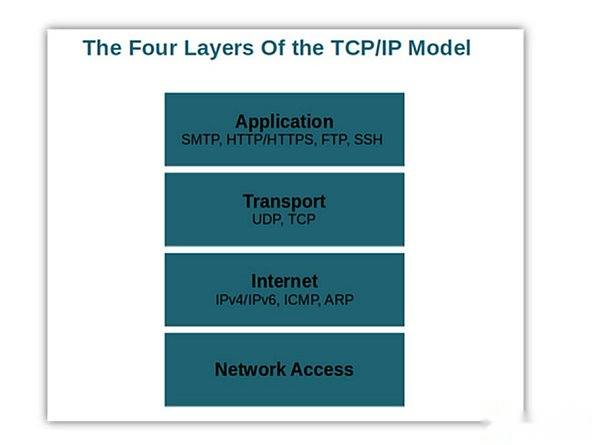
· Application layer: As the top layer, the application layer is a place for user interaction and data.The protocols include the SMTP protocol of the email, the HTTP/HTTPS protocol for web browsing, and the FTP protocol of file transmission, and so on.
· Transportation layer: This layer is established to be reliable and error -oriented.It divides the data into a packet and commands them to accurately pass in order.
· Internet layer: also called IP layer, its main role is to transmit packets and routes on the entire network.It uses protocols like IPv4/IPv6 to carry out data routes between various networks.
· Network access layer: This layer corresponds to the data link layer and physical layer corresponding to the OSI model.It focuses on the physical aspects of data transmission, and handle tasks such as MAC addressing and the management of Ethernet cables, wireless networks, network interface cards and drivers.
Layerzero is designed to run mainly on the application layer or transport layer, more like Wrapper (wrapper) above the existing protocol.Continue to quote the remarks of Not Boring:
“LayerzeroJust the transmission layer, andWormholeIt is also the verification layer.therefore,UniswapCanChainlinkReplace it with its own authentication set.At onceWormholeFor speaking, if you want this, you still need to use it13/19 GuardianModel.“
“We feelUniswapThe forum is more like a failure in the correct communication agreement and its role.“Bryantell me.“They want us to beWormholeorAxlar, But we are not at all.“
In the newly announced Layerzero V2, the most important change is Oracle and Relayer being replaced by the “decentralized verification network” (DVN) and “executors”. They do not require licenses:
“Now, any external network can becomeDVNApplications can choose any combination of them to approve messages.At the time of release,AnimocaAs well asBlockdaemonAs well asDelegateAs well asGitcoinAs well asNethermindAs well asObolAs well asP2PAs well asStablelabAs well asSwitchboardAs well asTapiocaAs well asSuperDuperAs well asPolyHedraandGoogle CloudIt is confirmedDVNOptions, and the adapter has been built to connectAxlarandChainlinkofCCIPEssenceThe roadmap also includes other bridges (includingWormhole) The adapter.“
It is very important for Axlar’s function that its value node provides security -the platform uses an intermediate consensus layer.This layer sets up consensus general standards for all Axlar message transmission. Unlike Layerzero’s approach, Layerzero leaves rules and consensus definition to each DAPP.Axlar provides a structured framework for message transmission, and Layerzero provides greater flexibility for DAPP.
Chia JENG Yang (from Pantera) made a concise description of this in his blog post:
LayerzeroThere is no regulation multi -chaindappThe complete security configuration file used, but a modular method, allowingdappDetermined the security you wanted to design and adopted, and gave the burden on the safety design selection to the developers.
Layerzero is “considering security by managing security”, while Axlar is the value acquisition of various layers -including the value of the network, service and infrastructure layers (such as the Relay and GAS services) -has opened many opportunities.Layerzero does not control the bottom.
This is another perspective from a modular perspective to look at the interoperability protocol.Similar to the modular blockchain theory, the function of the blockchain is divided into the execution layer, settlement layer, consensus layer, and data availability layer. We can also divide the cross -chain protocol as a modular block serving each function:
· Application: Explain data in standard mode
· Transmission: Move the data from one domain to another
· Verification: Make sure the validity of the data transmitted
It is not difficult to see that the most important thing here is the verification part. It refers to the process of ensuring the valid state of confirmation of the chain in each chain.When the two chain bases take action in each other’s state, this is very important.As far as Layerzero V2 is concerned, this part is basically outsourced to other entities.Axlar provides a reliable network to serve the verification layer.
(5.Wormhole GatewayProveAxlarAdvantages of architecture
We have discussed a lot about Layerzero, what about Wormhole?It has a valuation of 2.5 billion US dollars in the private equity market and has a strong influence between the MOVE -based chain such as Solana and SUI/Aptos. So what is it compared to Axlar?
Wormhole is similar to Axlar, especially on hub & amp; spoke models.If we continue to take a modular interoperability protocol as an example, Wormhole is also running the verification layer to provide real consensus.Although their trust mechanisms are different -WORMHOLE relies on Guardians’ reputation, and Axlar depends on economic pledge -but their differences are mainly the focus of ecosystems and business strategies.
Wormhole focuses on bridging EVM and Solana ecosystems, and Axlar, as a COSMOS chain, is more focused on the COSMOS ecosystem.It is worth noting that both Wormhole and Axlar were approved by Uniswap Governance for its deep bridge assessment report.(Note: Layerzero was not approved for centralization.)
But very interesting is that Wormhole recently announcedWormhole GatewayEssenceLet’s look at the specific content:
“Wormhole GatewayInCosmosThe specific application blockchain developed in the ecosystem is connected to multipleCosmosBridge of chain and applications.“
It sounds familiar?Isn’t this like Axlar in practice?Wormhole has decided to use COSMOS SDK to start its own Gateway chain, which will enable users to access more than 23 blockchains through an IBC -based liquidity router.It also acts as the sovereign verification layer of the Wormhole message, adding an additional security layer to the network:
GatewayThe purpose is to provide users with a more efficient and more cost -effective way, allowing them to transfer funds between different blockchain without additional bridges.This is fromWormholeA major progress of the bridge,WormholeThe bridge was once a decentralized agreement, known for its multi -chain connection ability.
Since the announcement in July, there is very little information about the development of Wormhole Gateway.The emergence of Wormhole Gateway shows that Axlar’s competition is becoming increasingly fierce.
However, the similarities designed by Gateway (using COSMOS SDK and IBC light client) prove the correctness of the selection of the Axlar architecture.It seems that Wormhole also stares at the same market, which highlights that Axlar’s approach is effective and attractive.
2,finance
(6.AXLToken economics has reduced inflation
The AXL tokens on the AXLAR network have three main functions, and the initial token is allocated as follows.
· In order to improve the fee for network usage, such as transaction fees.
· Incentive mechanisms to ensure network security by pledge.
· The governance of pledge and weighted voting.
>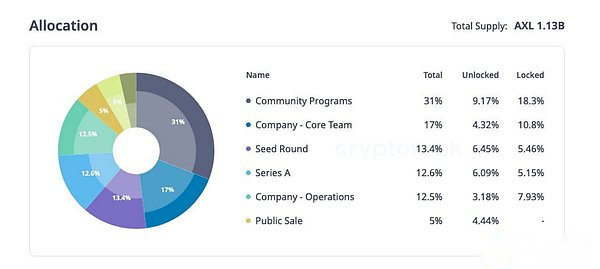
Recently, a new token economics proposal has introduced two important measures to improve its sustainability.
· Reduce network inflation
Earlier, the inflation rate of each external verification chain of the Axlar chain was 0.75%, resulting in a total inflation rate of 11.5%(1%basic inflation rate, and 14 external compatible chains, and each chain contributed 0.75%).This leads to about 14.5%of AXL’s pledged annual interest rate (APR).
A new proposal was passed on December 9, 2023 to reduce the inflation rate of each external chain to 0.3%.This adjustment reduces the total inflation rate to 6.7%.The reduction of this inflation rate is designed to obtain a balance between verifiers incentives and controllable expansion of network supply.
InGasDestruction mechanism
As far as Axlar is concerned, cross -chain transactions need to use AXL to pay GAS fees, and then allocate these AXL to pledges.Generally, the cost of processing a message through Axlar is about 0.2 AXL.A mid -term proposal (not voting) is recommended to remove these GAS fees from the loop supply.
Over time, this GAS destruction mechanism is expected to offset inflation.For example, the fixed GAS fee for each transaction (denominated at AXL) is $ 0.5, and the transfer of 5 basis points for a certain amount of assets can be charged.About 36.5 million US dollars).This is the prerequisite based on the daily processing of 100,000 transactions and a daily transaction volume of $ 100 million.This mechanism can effectively offset up to 10%of the inflation rate.
However, it is worth noting that AXLAR has not reached this scale. Recent data shows that AXLAR has dealt with about 4,000-5,000 transactions per day, and the daily transaction volume is nearly $ 20 million.However, advancing this proposal may make AXL token science closer to Ethereum models (in Ethereum’s token economics models, issuance and destruction to balance) may take Axlar on the road of shrinking.
(7) The market has not realizedAxlarOverlap network positioning
When assessing Axlar and other AMPs, it is natural to consider the relative valuation of Axlar.According to the private equity market financing situation, the valuations of Layerzero and Wormhole were $ 3 billion and $ 2.5 billion, respectively.If we compare these data with the current US $ 1.1 billion FDV, we will find that Axlar has 2 times the potential for growth.
However, our analysis shows that Layerzero is more in line with the application layer rather than the basic network layer.ItsV2andDVNStructure indicatesAxlarCan support itOracle/RelayInfrastructure is a real network layer that provides security.
Regardless of a person’s agreement to fat (fat protocol) What is the position of theory, the market still seems to be littering infrastructure agreements.On the other hand, Wormhole is developing its own chain to the model similar to Axlar, but Axlar is obviously leading in this field.
I want to pay attention to a metaphor used by Axlar’s founder Sergey. He compares Axlar to a overlapping network (overlay networkTo.This concept has not completely penetrated into the encrypted discourse, but the overlapping network is a key step in the early development of the commercial Internet. The service and rich content of the services and rich content are beyond the scope that the agreement can be guaranteed.I predict that as the development of Axlar virtual machines (AVM) and cross -chain DAPPS is becoming more and more mature, Axlar will no longer be regarded as a cross -chain message transmission protocol.
At that time, Axlar will be regarded as a unique entity -a comprehensive cross -chain overlap network on all L1, L2, application chain and rollup, and providing application deployment, routing, conversion, and conversion, and conversion, andSafety, realize true interoperability.
With the success of cross -chain applications (such as universal compatibility wallets), the market’s understanding of Axlar’s abstract vision may become clearer.”The blockchain is the city of the blockchain“The metaphor is expanded to the country, and Axlar can be compared to woven the entire world into a extensive underground Internet cable with a single information network.In this case, Layerzero sails the navigation and communication systems based on point -to -point routes similar to the point -to -point routes.
3,mood
(8.AxlarIt will continuedappCollaboration
In terms of business development, Axlar is quickly establishing a partnership with the DEFI agreement to enhance the cross -chain function:
InFRAX Finance: Axlar and FRAX are together to improve the cross-chain user experience. The two parties will cooperate to release a Axlusdc-Fraxbp Curve pool on Arbitrum and promise to provide $ 5,000 for the pool reward every month.In addition, FRAX Finance will integrate Axlusdc and FRAX in its product kits.
InVertex: Axlar and Vertex recently announced a cooperation aimed at promoting cross -chain interoperability.This integration will allow users to use Axlar’s network and Squid to perform smooth cross -chain deposit operations on Vertex.
IndydxIntegrated: Dydx has cooperated with Axlar and Squid to provide users with one -click login on its V4 platform.This integration allows users to use Axlar’s cross -chain infrastructure to easily get a DYDX chain address deposit or withdraw money from any blockchain.
InLido & amp; neutron: This cooperation aims to promote cross -chain interoperability and support the expansion of Lido’s liquidity pledged token WSTTH to the COSMOS ecosystem.Axlar and Neutron have been selected by LiDo as the preferred technical partner of the preferred ETH (WSTTH) bridge to the lido packaging liquidity.
(9.EVM-OSMOSISandCosmosThe traffic between the chain increases
Axlar is the main protocol connecting the EVM and the COSMOS chain, especially OSMOSIS.Recent trend shows that OSMOSIS is getting attention.
Defiance Capital 0xARTHUR believes that OSMOSIS’s strategic positioning is to benefit from the continuously expanding COSMOS ecosystem.Recently, the daily transaction volume of newly released tokens like TIA has increased by 50%-100%.In addition, the bullish mood around the entire COSMOS ecosystem is very common, especially with the launch of the DYDX chain and the expectations of NOBLE USDC/WBTC.As the main liquidity center based on COSMOS assets, OSMOSIS has a total lock value (TVL) of $ 122 million, which further consolidates its position.
An analysis article written by 0xhopydoc of Mobius Research is likeOsmosisThis“fat“The application chain provides a powerful argument.This article pointed out that the application chain is cultivating its own ecosystem to make full use of the dual advantages of agreements and applications.The analysis touches why OSMOSIS wants to start a positive feedback loop, which may become a leading liquidity center because it establishes an ecosystem in an orderly manner to establish an AMM -based application chain.This includes the integration of Defi primitives, such as Mars Protocol for the currency market and Levana Protocol on a permanent futures exchange.
Axlar’s recent data shows that in the past 30 days, the event has increased significantly, especially the connection related to OSMOSIS.This trend highlights the growth of traffic between EVM, OSMOSIS and other COSMOS chains, and highlights the increasingly important role of Axlar.
>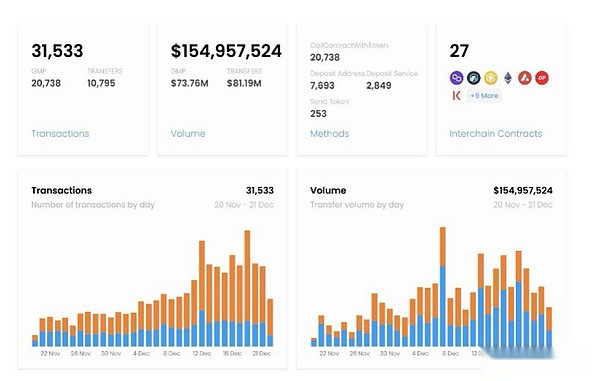
(10.LayerzeroThe airdrop will cause attention to the interoperability agreement
I admit that the last reason may look a bit deliberate, because my goal is to list a tidy 10 list, but it is worth noting that the airdrop expectations of Layerzero and Wormhole expectations may cause major attention to the cross -chain agreement.
Earlier this month, Layerzero confirmed the airdrop plan set in the first half of 2024, which caused the community to excite.
>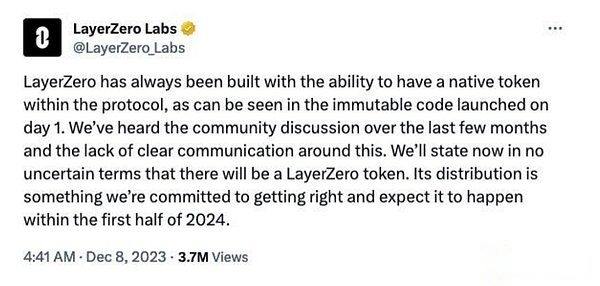
In addition, more and more people speculate that Wormhole may be airdropping and issuing tokens.A document in February 2023 introduced the private token sales plan for institutional investors.750 million HOLE tokens were sold at a price of $ 0.25 per generation, accounting for 7.5%of the total supply, and raised about $ 187.5 million. The project’s valuation was $ 2.5 billion.
It is expected that these airdrops and token issuance will be held in 2024, which will greatly increase people’s interest in cross -chain agreement.If the transaction prices of these two tokens are valuations of the private equity market of US $ 3. billion and $ 2.5 billion, respectively, it may prompt people to re -evaluate the value of AXELAR and make it closer to similar products.
4,risk
Due to its profitability, the cross -chain agreement often becomes the goal of malicious actors.Common risks include capital loss, unauthorized tokens casting and fraud transactions.The root causes of these vulnerabilities attack are different, from the damage to the “dumping carpet” and the bridge reception to the private key leakage and the ownership takeover.
Axlar is facing similar security challenges. Although these challenges can be minimized, they can never eradicate.Axlar uses locking and casting (lock and mint) The mechanism is performed by the token bridge.According to Axelarscan’s data, about $ 150 million is locked in Ethereum’s Axlar Gateway contract, which is a huge amount of funds that may attract hackers.
>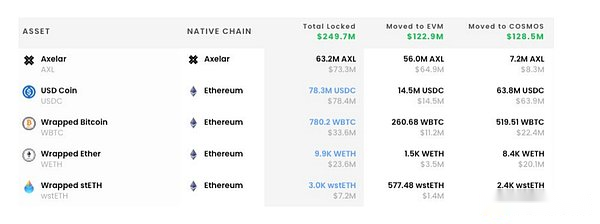
LlamariskIn a security report in April, the Gateway contract can be upgraded through multiple signatures of 4/8. The multiple signature is essentially locking the funds in Axlar and can be able to apply for a transfer rate limit.
“4/8Multiple signatures control the contract upgrade, which can be effectively kept and lockedAxlarFund.In addition, it also has the right to appoint a transfer rate limit.“
However, since June, Axlar has adopted measures to promote decentralized networks by allowing Validator to jointly approve the upgrade of smart contracts.This measure solves an important security issue of Axlar, which is mentioned in the UNISWAP bridge assessment report.
5,in conclusionIntersectionWhat is the future of cross -chain?
Think about the typical journey of an encrypted new user to experience today: First, they use credit cards or transfer to a centralized exchange (CEX) through a bank, and then buy some tokens, such as SOL or ETH.Then they became interested in NFT and DEFI and wanted to try DAPP on the chain.Now, they want to withdraw money, they look at a daunting network menu to choose from.
>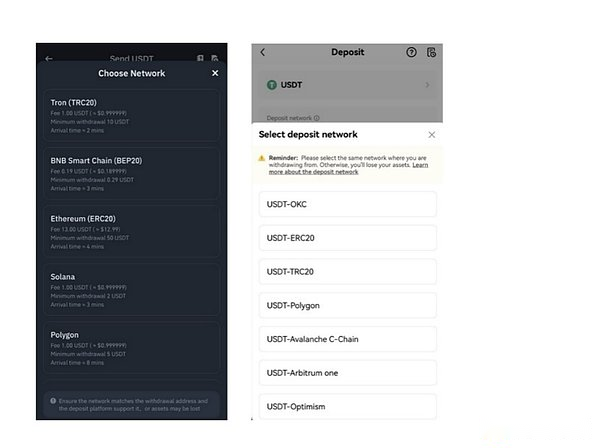
It is expected that they can discern the USDT to TRON (cheap and fast, but no DAPP) or Ethereum (expensive and slow, but the best liquidity) or ZKSYNC (cheaper and faster Ethereum L2).What kind of subtle difference is unrealistic.
Involved in Sol and other assets on CEX and other CEXs, the situation becomes more complicated. Users can extract SOL on the BNB chain.The additional complexity is involved here, that is, SOL only survives on the Solana chain, and they receive the packaging version recognized by the Binance Exchange on the BNB chain.This complexity confuses the novice and confuses veterans.
Kyle from Multicoin Capital is also disappointed with the confusion of the multi -chain balance. The balance of the multi -chain is a common interface for most wallets today.
>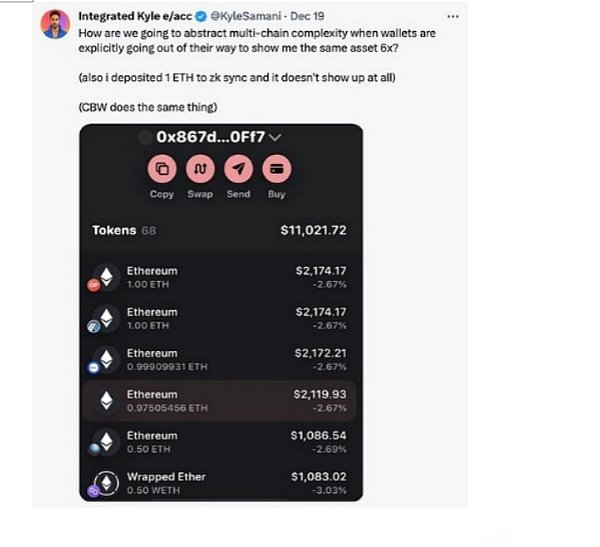
This complexity comes from the chain of the custody tokens.The user interface is still very complicated, because the liquidity of the bottom layer is fragmented, and the application logic is isolated between the chains.This situation is unlikely to change until the real cross -chain DAPP promoted by cross -chain AMP.
Now, imagine another future driven by a cross -chain wallet based on Axlar.In such a future, users at centralized exchanges can withdraw any tokens through Axlar.In the general wallet, the balance is uniform; the difference between the ETH on the six different chains has become unrelated.When the user interacts with ETH on a chain, when they deposit in the income vault like Sommelier, they only maintain a single balance and position.Behind the scenes, the income agreement uses Axlar to save their ETH into the most profitable pools or vaults on each chain.
This cross -chain futures simplify the user experience, unify the decentralized liquidity, and make full use of the potential of decentralized finance, marking a major leap in the availability of the blockchain.This is the web3 future that I am eagerly looking forward to.








